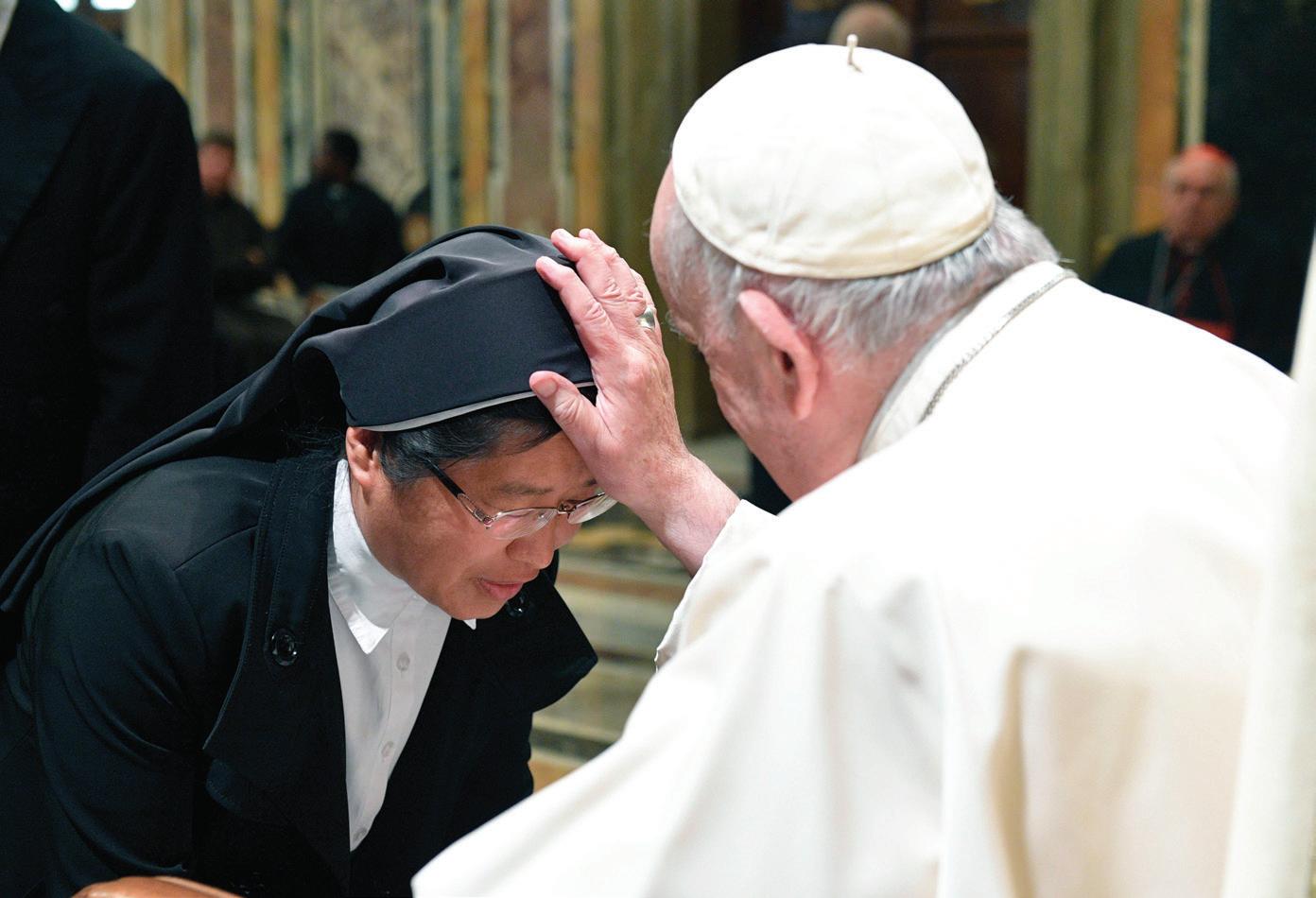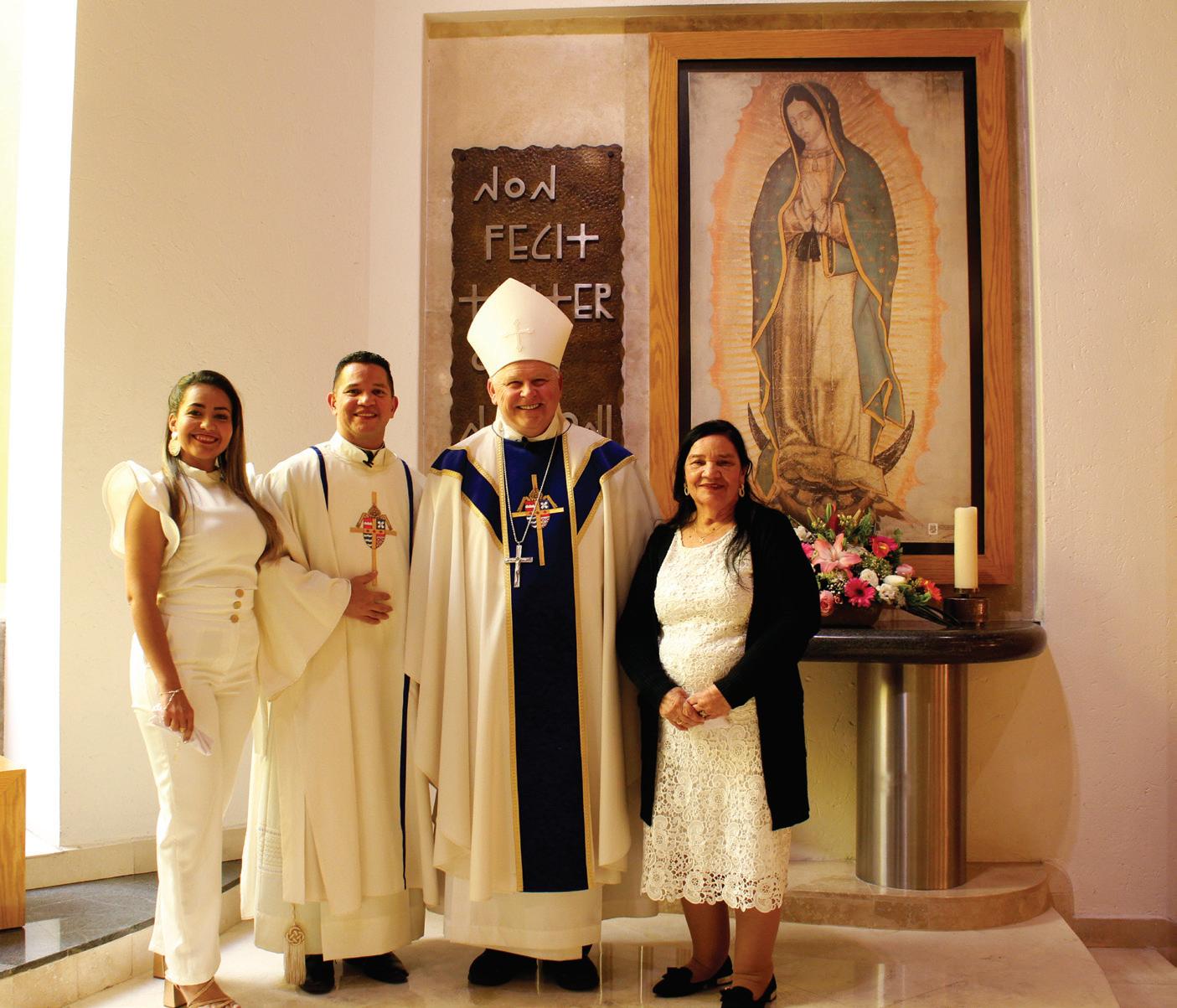
6 minute read
Pope Francis on World Day for Consecrated Life: Women, men religious have a ‘special role’ in the Catholic Church
By Hannah Brockhaus Catholic News Agency
On the 27th World Day for Consecrated Life, Pope Francis recalled the special role religious Brothers and Sisters have in the Catholic Church.
“In the People of God, sent to bring the Gospel to all people, you consecrated men and women have a special role,” the Pope said in a written message for Feb. 2.
This special role, he continued, stems “from the special gift you have received: a gift that gives your witness a special character and value, by the very fact that you are wholly dedicated to God and his kingdom, in poverty, virginity, and obedience.”
Pope Francis’ message was read at the beginning of a Mass for consecrated men and women in Rome’s St. Mary Major Basilica on Feb. 2.
Pope Francis usually celebrates a
For all that information you have gathered will witness to others the simple phrase: Jesus, I love you.”
After the homily, Deacon Alvarado stood before the bishop, who questioned him to declare his intent to undertake the office of deacon before the people of God. The deacon responded “I do” to each question. Immediately following came the promise of respect and obedience to the bishop, where Deacon Alvarado knelt before Bishop Stika, placing his hands in the bishop’s hands. Afterward, he laid prostrate before the bishop as seminarian Abrahan da Silva sang the Litany of the Saints.
Once the ordination prayer was completed, the new deacon received the vestments of a diaconal stole and dalmatic. Father Torres vested Deacon Alvarado.
Once vested, Deacon Alvarado knelt before Bishop Stika to place his hands upon the Book of the Gospels, to which Bishop Stika said, “Receive the Gospel of Christ, whose herald you have become. Believe what you read, teach what you believe, and practice what you teach.” Rising once more to kneel before the bishop, he approached Bishop Stika for the laying on of hands and prayer of ordination.
The gifts were brought forth for Communion by Deacon Alvarado’s mother and family friend.
At the conclusion of Mass, Bishop Stika offered his thanks to Deacon Alvarado’s mother and those who watched from home, for the beautiful music, and the hospitality of the seminary.
A reception was held, hosted by the seminary, following the ordination Mass. Deacon Alvarado visited with the guests and gave blessings to those in attendance.
He also gave a speech in which he thanked the Diocese of Knoxville’s Vocations Office “for believing in me, for accompanying me in this process”; his formators; his spiritual director; his pastor at his parish assignment, “an angel of God”; the “beautiful people” who work at the seminary; his brother seminarians; and the people of the Diocese of Knoxville.
“I chose the right one,” he said about joining the Diocese of Knoxville.
Deacon Alvarado’s first Mass as a deacon was on Jan. 23 at the seminary. The Gospel reading of the day read, “But whoever blasphemes against the Holy Spirit will never have forgiveness, but is guilty of an everlasting sin.”
In Deacon Alvarado’s homily, he shared, “What has filled my heart with happiness the most throughout my process of formation and since I began my ministry has not been the putting on of my vestments, the image of me serving at the altar, or the feeling of status that I have acquired at the ecclesiastic or social level.”
“What has truly moved me the special Mass in St. Peter’s Basilica to mark the World Day for Consecrated Life but was unable to do so this year because the day fell in the middle of his Jan. 31–Feb. 5 trip to the Democratic Republic of Congo and South Sudan.
The Feb. 2 Mass in St. Mary Ma- jor was celebrated by the prefect of the Vatican’s Dicastery for Consecrated Life, Cardinal João Braz de Aviz, who read the pope’s message to those present.

“When you hear this message from me, I will be on mission in the Democratic Republic of Congo, and I know that I will be accompanied by your prayers,” the Pope said. “In turn, I want to assure you of mine for the mission of each of you and your communities.”
“All of us together are members of the Church,” he continued, “and the Church is in mission from the first day, sent by the Risen Lord, and will be so until the last, by the power of His Spirit.”
The theme of the 2023 World Day for Consecrated Life is “Brothers and Sisters in Mission.”
The Catholic Church celebrates the World Day for Consecrated Life every year on Feb. 2, the feast of the Presentation of the Lord, also of St. Juan Diego, the apparitions, and the community’s response to Mary’s visit. The original basilica, built in 1709, is now a museum. The new basilica, which houses the tilma, was built in 1979. most is the knowledge that evil can leave the hearts of those who are found to be possessed by it. Through my preaching of the Word of the Lord, and goodness, the presence of Jesus can reign in their lives instead,” he said. “The purpose of my vocation is to proclaim Christ, and to tell the world that it is worth it to follow Jesus. My heart is very happy to know that I can proclaim this with all the strength I have through my ministry. I look forward to doing this at a much deeper level through the priestly ministry.”
Near the basilica is a statue of Mary, marking the site of the second apparition on the day St. Juan Diego changed his path to visit his sick uncle and avoid an encounter with the Blessed Mother. At the site of the statue, water flows where a well opened under the feet of Mary after her appearance. Continuing along the path, the Chapel of Los Indios (the Chapel of the Indians) is the site of St. Juan Diego’s home and final resting place.
Inside the Chapel of Los Indios is an image of the saint above the main altar. The original ruins of his humble home are attached to the side of the chapel and can be viewed from inside the chapel.
The group, led by Deacon Alvarado and seminarian da Silva (who are the farthest geographically of all Diocese of Knoxville seminarians), returned to Mexico City, where they visited the Metropolitan Cathedral of the Assumption of the Most Blessed Virgin Mary into Heaven. Building for this cathedral began in 1571 and features many architectural and art periods, including Baroque, Gothic, and Neoclassical.
The choir stalls are still in active use by the priests, auxiliary bishops, and archbishop, who is Cardinal Carlos Aguiar Retes of the Metropolitan Archdiocese of Mexico. The dark, intrinsically detailed carved wood included scrollwork and carvings of numerous saints. The cathedral also includes works of art, religious relics, crypts, and 16 chapels.
Bishop Stika celebrated the Mass in which Deacon Alvarado preached.
In beginning his ministry, Deacon Alvarado proclaimed the Gospel, served at the altar, at the Communion rite announced, “Let us offer each other the sign of peace,” and at the concluding rite exclaimed, “Go in peace.” Ms. Suarez de Alvarado and Ms. Caiafa, seminarians, and those traveling from the Diocese of Knoxville were present.

Prior to the ordination, the group from Knoxville visited the National Basilica of Our Lady of Guadalupe. The tilma of St. Juan Diego with the image of Our Lady of Guadalupe is on display at the basilica. Three moving sidewalks run below the image for visitors to view and ask for Our Lady’s intercession. Our Lady’s image is displayed high enough to be seen during Mass as well.
Pilgrims from all over gather in the basilica to see the Blessed Mother, and Mass is celebrated every hour on the hour from 7 a.m. to 8 p.m. daily (and starts at 6 a.m. on Sunday). Flowers are brought to Our Lady all day, lining the walls of the sanctuary. Flags from each country where Our Lady is patroness also hang just outside the sanctuary. Confession is available, as are the blessing of religious items, and a Catholic gift shop.
From the basilica, the group walked from Mexico City up Tepeyac Hill to the Capilla del Cerrito, the Chapel of the Little Hill, at the site of Our Lady’s first apparition to St. Juan Diego. The “hill” is actually an elevation of more than 8,300 feet.
The chapel originally was built in 1666 and includes traditional architecture. The chapel walls are lined with paintings that narrate the story
The chapels surround the interior with different devotions unique to the Mexican culture, such as “Señor del Veneno” the Lord of Poison, a black crucifix. Dating from the 18th century, the bishop of that time prayed at the crucifix as he entered the cathedral.
However, there were those who wished the bishop would die. They put poison on the feet of the wooden Jesus, knowing that the bishop would kiss the feet when he was done praying. The bishop did as always and kissed the feet, but he did not die. Instead, the Jesus sculpture turned black. The number of faithful who venerate him now is so great that the crucifix was moved to the altar at the entrance of the cathedral, the altar of forgiveness.
The cathedral, like many other structures in the downtown area, is sinking as the downtown was built on what used to be a giant lake. A pendulum hangs on the center aisle of the cathedral to measure the shifting foundation. ■
Beth Parsons manages the Diocese of Knoxville’s Office of Vocations and attended the ordination Mass for Deacon Renzo Alvarado Suarez










